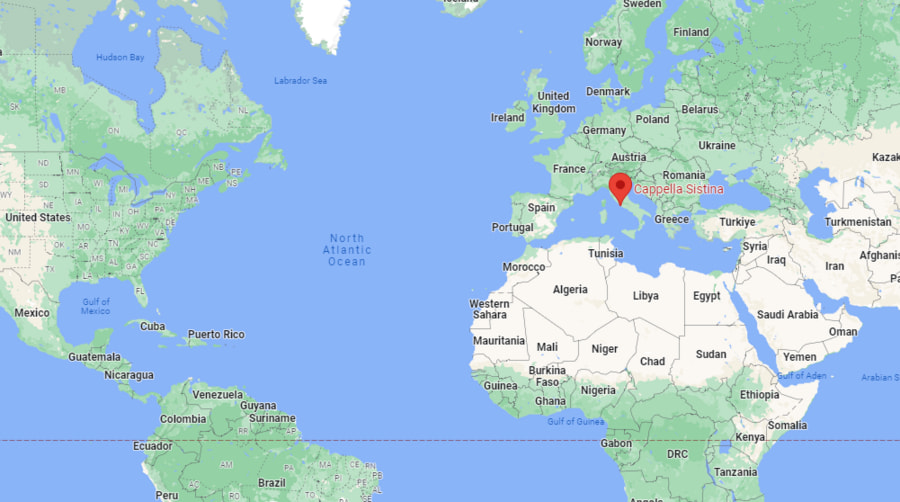The Sistine Chapel is located within Vatican City, an independent city-state situated in the heart of Rome, Italy. Vatican City is the smallest internationally recognized independent state in the world and is the spiritual and administrative headquarters of the Roman Catholic Church. The Sistine Chapel is part of the Apostolic Palace, the official residence of the Pope. It is renowned for its stunning frescoes, including the famous ceiling painted by Michelangelo. Visitors can access the Sistine Chapel through the Vatican Museums, which house a vast collection of art and historical artifacts.
Location Map of Sistine Chapel, Vatican City
 About Map: Map showing Where is Sistine Chapel, Vatican City located in the Map.
About Map: Map showing Where is Sistine Chapel, Vatican City located in the Map.
About Sistine Chapel
The Sistine Chapel is a renowned chapel located within Vatican City, a sovereign city-state within Rome, Italy. Here are some important details about the Sistine Chapel.Location: The Sistine Chapel is part of the Apostolic Palace, which serves as the official residence of the Pope. It is situated within the Vatican Museums, a complex of art galleries and museums within Vatican City.History: The construction of the Sistine Chapel was commissioned by Pope Sixtus IV and was completed in 1481. It has since served as the site for important religious ceremonies, including papal elections and the conclave for the selection of a new Pope.
Architecture: The Sistine Chapel follows a rectangular plan with a simple exterior. Its interior is renowned for its artistic beauty and the iconic frescoes that adorn its walls and ceiling.Ceiling Frescoes by Michelangelo: The most famous feature of the Sistine Chapel is the ceiling frescoes painted by Michelangelo between 1508 and 1512. The ceiling depicts various scenes from the Book of Genesis, including the Creation of Adam, the Creation of Eve, and the Great Flood.
Last Judgment Fresco: Michelangelo also painted the massive Last Judgment fresco on the altar wall of the Sistine Chapel between 1536 and 1541. It portrays the Second Coming of Christ and the final judgment of souls.Artistic Significance: The Sistine Chapel is considered a masterpiece of Renaissance art and is celebrated for its harmonious design and unparalleled frescoes. The works of art by Michelangelo, as well as other prominent artists of the time, have made it a significant cultural and historical site.
Religious Significance: The Sistine Chapel holds great religious importance for the Catholic Church. It serves as the site for the Papal conclave, where cardinals gather to elect a new Pope. It is also used for other important liturgical and religious ceremonies.Visitor Access: The Sistine Chapel is accessible to the public as part of the Vatican Museums. Visitors can explore the chapel as part of a tour of the museums, which require an entry fee. However, note that during religious functions, the chapel may be closed to tourists.The Sistine Chapel stands as a testament to the artistic genius of Michelangelo and the rich religious and cultural heritage of the Catholic Church. Its exquisite frescoes and historical significance continue to captivate visitors from around the world.
World Travel Destinations
- 100 Wonders Of The World
- 7 Wonders Of World
- Where is Acropolis
- Where is Alhambra
- Where is Amalfi Coast
- Where is Amazon Rainforest
- Where is Angel Falls
- Where is Angkor Wat
- Where is Bali
- Where is Banaue Terraces
- Where is Bora Bora
- Where is Borobudur
- Where is Burj Khalifa
- Where is Cappadocia
- Where is Carlsbad Caverns
- Where is Chichen Itza
- Where is Colosseum Of Rome
- Where is Dubrovnik
- Where is Easter Island
- Where is Eiffel Tower
- Where is Fjords Of Norway
- Where is Galapagos Islands
- Where is Grand Canyon
- Where is Great Barrier Reef
- Where is Great Pyramid Of Giza
- Where is Great Wall Of China
- Where is Iguazu Falls
- Where is Konark Temple
- Where is Leaning Tower Pisa
- Where is Louvre Museum
- Where is Machu Picchu
- Where is Marrakesh
- Where is Matterhorn
- Where is Mecca
- Where is Mount Everest
- Where is Pagan Temples
- Where is Petra
- Where is Pompeii
- Where is Portofino
- Where is Potala Palace
- Where is Sahara Desert
- Where is Santorini
- Where is Sistine Chapel
- Where is Stonehenge
- Where is Suez Canel
- Where is Taj Mahal
- Where is Teotihuacan
- Where is Terracotta Warriors
- Where is Valley Of The Kings
- Where is Versailles
- Where is Victoria Falls
- Where is Mount Rushmore
- Where is Prague
- Where is Tunis
- Where is Curacao
- Where is Babylon
- Where is Death Valley
- Where is Tahiti
- Where is Oak Island
- Where is Mount Fuji
- Where is Timbuktu
- Where is Canary Islands
- Where is Monte Carlo
- Where is Atlantis
- Where is Dead Sea
- Where is Amalfi Coast
- Where is Kosovo
- Where is Great Barrier Reef
- Where is Panama Canal
- Where is The Red Sea
- Where is Aconcagua Mountain
- Where is Azores
- Where is Devil'S Tower
- Where is Antwerp
- Where is The Faroe Islands
- Where is Santorini
- Where is Kilimanjaro
- Where is Banff National Park
- Where is Mount Olympus
- Where is Ninevah
- Where is Mount Etna
- Where is Deadwood
- Where is Lake Titicaca
- Where is Yucatan Peninsula
- Where is Mount Mckinley
- Where is Angel Falls
- Where is The Blue Lagoon
- Where is Petrified Forest
- Where is Rock Of Gibraltar
- Where is Glass Beach
- Where is Atacama Desert
- Where is Mount Ararat
- Where is Falkland Islands
- Where is Channel Islands
- Where is Badlands National Park
- Where is Tree Of Life
- Where is Dubrovnik
- Where is Loch Ness
